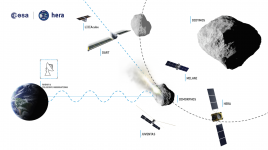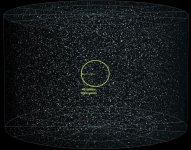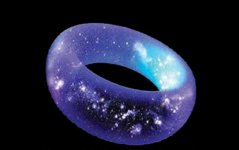Who writes these Wikipedia articles? (don't answer, I could look up the history to see, it's a rhetorical question of astonishment about the text)
Is there a mission in the planning to send a scientific probe to it (yet)? I can imagine one or two billionaires thinking "hey, that's a big rock already up there in space, I wonder what it would cost to nudge it into an Earth orbit and start mining it for an orbital manufacturing plant and such."
2039 interview: "No, I just wondered what I could do with that asteroid, I wasn't really intending to become the first multi-trillionaire."
They sure go into various ways of explaining how close that thing's gonna come to Earth.The distance, a hair's breadth in astronomical terms, ...
Is there a mission in the planning to send a scientific probe to it (yet)? I can imagine one or two billionaires thinking "hey, that's a big rock already up there in space, I wonder what it would cost to nudge it into an Earth orbit and start mining it for an orbital manufacturing plant and such."
2039 interview: "No, I just wondered what I could do with that asteroid, I wasn't really intending to become the first multi-trillionaire."
There is a dual mission planned for launch in 2024 that will travel to the Didymos pair of near-Earth asteroids.Is there a mission in the planning to send a scientific probe to it (yet)?
NASA will fire its DART (Dual Asteroid Redirection Test) spacecraft at the smaller of the pair, Dimorphos, which orbits Didymos like a moon.
Then the ESA Hera probe will follow up with a post-impact survey that could turn this experiment into a future planetary defence technique.
The Great Pyramid of Giza sized Dimorphos will be the first object in the solar system to have its orbit shifted by human effort in a measurable way.
ESA - Hera
Attachments
The energy involved in these big asteroids is phenomenal. Their velocities are especially high if they've been nudged out of orbit a long way off - say in the Oort cloud, or the outer reaches of the Kuiper belt, so they have a long in-fall (or 'fetch') to the inner solar system.
From wiki re the Chicxulub asteroid that wiped the dinosaurs out :-
"The authors simulate one scenario using an impactor that is 17 km in diameter, with a density of 2,650 kg/m3 and therefore a mass of about 6.82×10^15 kg, striking Earth at 12 km/s with an angle of 60° from horizontal. In another scenario that also approximately matches the evidence they analyzed, they simulate an impactor that is 21 km in diameter, with a mass of 1.28×10^16 kg, a speed of 20 km/s, and an impact angle of 45°/"
If my math is correct that's ~1 million billion tons, or put another way, ~1000 trillion tons travelling at 43 000 km/hour for the lower velocity estimate and 72 thousand km/h for the upper estimate.
Chicxulub crater - Wikipedia
The problem is that with something moving that fast and that big, you have to be able to address it years before impact in order to steer it away. It will happen again sometime in the Earth's future. I hope by that time we have a way to deal with it effectively.
From wiki re the Chicxulub asteroid that wiped the dinosaurs out :-
"The authors simulate one scenario using an impactor that is 17 km in diameter, with a density of 2,650 kg/m3 and therefore a mass of about 6.82×10^15 kg, striking Earth at 12 km/s with an angle of 60° from horizontal. In another scenario that also approximately matches the evidence they analyzed, they simulate an impactor that is 21 km in diameter, with a mass of 1.28×10^16 kg, a speed of 20 km/s, and an impact angle of 45°/"
If my math is correct that's ~1 million billion tons, or put another way, ~1000 trillion tons travelling at 43 000 km/hour for the lower velocity estimate and 72 thousand km/h for the upper estimate.
Chicxulub crater - Wikipedia
The problem is that with something moving that fast and that big, you have to be able to address it years before impact in order to steer it away. It will happen again sometime in the Earth's future. I hope by that time we have a way to deal with it effectively.
Last edited:
I know I am doomed. Just like the other 8.5 billion other humans on the planet. Its highly unlikely I'll be around in 30 or 40 years. Its just the cycle life.
😀
😀
Today's relatively quick random thought. Today I was watching an episode of Stargate, and it was mentioned the Gate addresses of the artificial wormholes were regularly adjusted for spacial locale drift, it got me wondering. Aside from the wobble of the Earth orbit caused by the Moon, other planets, the motion of Sol around the Milky Way, the Milky Way movement interactions with the Local Group, the Local Group movements interacting with the Virgo Supercluster, and the movent of the even more distant larger Laniakea cluster and the filaments beyond...
What is any overall movement referenced to? If the energy and matter in this universe did come into existence simultaneously everywhere in a tremendous Big Bang, on the macro scale of further than we can observe- is some or all of it moving so fast as to experience time distortion to an outside the universe observer?
Might the whole Big Bang and after time was released from it, seem to be over in an undefined instant?
What is any overall movement referenced to? If the energy and matter in this universe did come into existence simultaneously everywhere in a tremendous Big Bang, on the macro scale of further than we can observe- is some or all of it moving so fast as to experience time distortion to an outside the universe observer?
Might the whole Big Bang and after time was released from it, seem to be over in an undefined instant?
That's a wizard question!What is any overall movement referenced to?
The answer is:
The Cupboard under the Stairs,
4 Privet Drive,
Little Whinging,
Surrey
😀
Attachments
What is any overall movement referenced to?
See: theory of relativity. You can use any frame, including a frame "relative" to the 2.7K CMB radiation.
But the universe is still expanding in any reference frame.
Last edited:
rayma is referring to the cosmic standard of rest - the co-moving stationary frame of the Hubble flow which uses precise measurements of the cosmic microwave background (CMB)
The 'Hubble flow' describes the motion of galaxies due solely to the expansion of the Universe. Hubble Flow | COSMOS
Thre are two common ways of describing the motions within our Milky Way galaxy:
If no other reference frame is given, we may assume that astronomers are using the International Celestial Reference Frame (ICRF).
Celestial Reference Frame
I'm no expert - I looked it all up - and there's more where that came from! 😀
The 'Hubble flow' describes the motion of galaxies due solely to the expansion of the Universe. Hubble Flow | COSMOS
Thre are two common ways of describing the motions within our Milky Way galaxy:
- By measuring velocities with respect to the the average motion of stars near the Sun - known as the Local Standard of Rest (LSR).
- By measuring velocities with respect to the plane of the galaxy and its centre.
If no other reference frame is given, we may assume that astronomers are using the International Celestial Reference Frame (ICRF).
Celestial Reference Frame
I'm no expert - I looked it all up - and there's more where that came from! 😀
I can't answer that question, mainly because I can't grasp the concept of an "outside the universe observer".If the energy and matter in this universe did come into existence simultaneously everywhere in a tremendous Big Bang ... is some or all of it moving so fast as to experience time distortion to an outside the universe observer?
If you define the universe to mean all the things that could possibly exist in all of space and time, then there can't be anything outside the universe.
There is an outside to our observable patch of the universe, but beyond that boundary there are presumably more galaxies behaving just like the ones we are able to observe.
Attachments
I read a few weeks ago, that because the Planck observatory detected no curvature the universe, it is likely that if it is finite in size, it is of the order of 20 trillion LY in diameter. So to your point Galu, there is a lot outside of our 46 billion LY radius bubble that we will never see.
(Almost makes me want to question the BB. How do you fill a 20 trillion LY bubble with stars, galaxies, and clusters in just 13 billion LY? There is an awful lot of stuff speeding way at >>> c. The Hubble constant is c70 m/s/Mpc).
(Almost makes me want to question the BB. How do you fill a 20 trillion LY bubble with stars, galaxies, and clusters in just 13 billion LY? There is an awful lot of stuff speeding way at >>> c. The Hubble constant is c70 m/s/Mpc).
Last edited:
I can't answer that question, mainly because I can't grasp the concept of an "outside the universe observer".
I know... and why a standing cylinder... why not a duck.
//
It all depends on how we define the universe. One definition is that the universe is all the things that could possibly exist in all of space and time....the universe, it is likely that if it is finite in size, it is of the order of 20 trillion LY in diameter. So to your point Galu, there is a lot outside of our 46 billion LY radius bubble that we will never see.
Even if the universe has a finite size, and we imagine something outside that volume, then whatever is outside also has to be included in the universe.
If the universe is infinite in size, and has no edge, then there's no outside to even talk about.
A duck or "not a duck"?I know... and why a standing cylinder... why not a duck.
That is the cosmic question! 😉
Attachments
It all depends on how we define the universe. One definition is that the universe is all the things that could possibly exist in all of space and time.
Even if the universe has a finite size, and we imagine something outside that volume, then whatever is outside also has to be included in the universe.
If the universe is infinite in size, and has no edge, then there's no outside to even talk about.
Yes - agree. Perhaps I should have mentioned that in the description I gave earlier, the author was considering a 'closed' universe - so if you could look far enough, you would see the Milky Way. However, given that galaxies are moving away from us at > c, this is never going to happen (which the writer also noted).
I think we mentioned, way back, that if you travel far enough in a closed universe, you would end up back where you started.
We likened it to the Asteroids video game where the ships and asteroids live on the surface of a 4-dimensional torus.
mscroggs.co.uk Blog: Video game surfaces
We likened it to the Asteroids video game where the ships and asteroids live on the surface of a 4-dimensional torus.
mscroggs.co.uk Blog: Video game surfaces
Attachments
That gaming link was rather interesting for the mappings. Even a hyperbolic space has been gamed!
AFAIK, we might live on a torus embedded in 4D. It has flat Gaussian curvature apparently. Unlike the 3D embedding. 😎
Disappointing night for the Moon/Venus/Spica conjunction. I did glimpse the New Moon but too much cloud for anything else. I did spot Venus on Tuesday. Very low and left of the setting sun, just above the usual clouds.
Poor picture tonight. I wasn't trying very hard with all the light pollution from Southsea Funfair and my cheapie camera handheld. The Moon was in a gap in the clouds.
AFAIK, we might live on a torus embedded in 4D. It has flat Gaussian curvature apparently. Unlike the 3D embedding. 😎
Disappointing night for the Moon/Venus/Spica conjunction. I did glimpse the New Moon but too much cloud for anything else. I did spot Venus on Tuesday. Very low and left of the setting sun, just above the usual clouds.
Poor picture tonight. I wasn't trying very hard with all the light pollution from Southsea Funfair and my cheapie camera handheld. The Moon was in a gap in the clouds.
Attachments
Judging by the amount of blur in that photo, Steve, you might just as well have been riding in a Waltzer! 😀Poor picture tonight. I wasn't trying very hard with all the light pollution from Southsea Funfair and my cheapie camera handheld.
Come to think of it, the Waltzer is an interesting combination of three independent motions which can be seen at the end of this short film clip:
BBC Two - i-Maths, Episode 1, The Waltzer fairground ride
The resultant motion of a rider must be complex and I'm not surprised that I can't find the Walzer included in any Funfair Physics discussions.
I wonder if there's an astronomical analogy of the Waltzer?

- Status
- Not open for further replies.
- Home
- Member Areas
- The Lounge
- What is the Universe expanding into..









